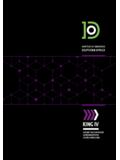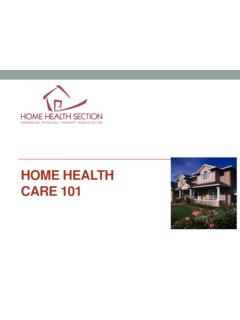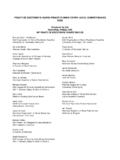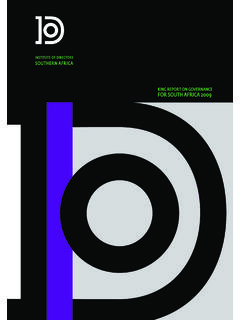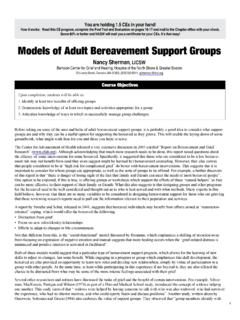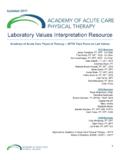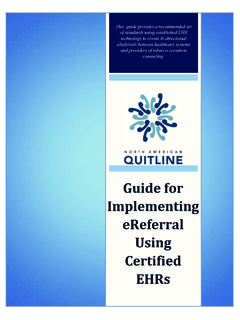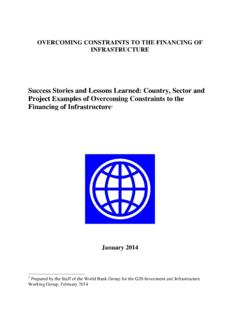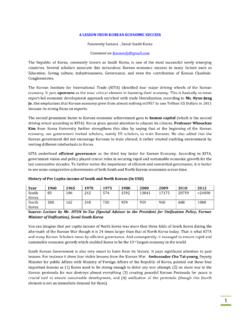Transcription of The Hospital Noise Project: Lessons on Addressing …
1 2012 Webinar Series The Hospital Noise Project: Lessons on Addressing Noise from 241 Hospitals Dial-in Number: 1-877-668-4493 Passcode: 801 889 969 Gary S. Madaras, , Director, Making Hospitals Quiet Nan Apps, Director, Service Excellence at Bassett Healthcare Defining Patient Experience - The Beryl Institute Upcoming Patient Experience Regional Roundtables Chicago September 20 Host site: Orlando November 8 Host site: Housekeeping All participant phone lines are muted The presentation will run 45-50 minutes with about 10-15 min for Q&A Q&A will be conducted through the chat function. Please submit questions to the host for a facilitated Q&A after the presentation. Webinar materials and session recording will be available for all attendees (an email will notify you when available with the appropriate link) A post-webinar survey will be distributed following today s session Today s Presentation The Hospital Noise Project: Lessons on Addressing Noise from 241 Hospitals Gary S.
2 Madaras, , Director, Making Hospitals Quiet Nan Apps, Director, Service Excellence at Bassett Healthcare The Hospital Noise Project recently studied Noise reduction efforts in 241 hospitals. Leaders described their approach, reported their level of success and reviewed the results they achieved. Themes found within the success stories and Lessons learned will be shared highlighting that the highest levels of success achieved by hospitals are those taking a holistic approach, using a well-formulated and executed plan to reduce Noise . These methods are deployed as an ongoing initiative as opposed to a tactical checklist being addressed simply as resources permit. In this webinar participants will: Learn how hospitals are approaching Noise reduction. Gain valuable insight into Hospital Noise reduction through success stories and Lessons learned.
3 Realize what differentiates those experiencing poor success from those experiencing good/great success with their Noise reduction efforts. Gain a perspective making their Noise reduction efforts more successful Lessons on Addressing Noise from 241 Hospitals DISCOVERIES FROM THE Hospital Noise PROJECT Jason A. Wolf, Executive Director Gary S. Madaras, Program Director Nan Apps Director, Service Excellence White Paper Available at Agenda Project Overview Study Discussion The State of Patient Experience in American Hospitals 2012 The Beryl Institute What are your organization s top three priorities for improving the Patient Experience? 2012 The Beryl Institute The Noise Project 20 Survey Questions 240+ Respondents The purpose of the Noise Project was to investigate what hospitals are doing to address Noise in their facilities, identify structure and practices and determine trends and outcomes around this top priority issue.
4 2012 The Beryl Institute Noise Project Bias Respondents tended to be early adopters in the effort against Noise . 65% of respondents were within the first 2 years of their effort. The large group of hospitals that have not yet started any efforts to reduce Noise represent a larger portion of the population and were not likely to participate in this study. 2012 The Beryl Institute Noise Project Findings .. the data show that collectively, the healthcare industry is struggling to address Noise or achieve any significant gains. 2012 The Beryl Institute Q2: What was the catalyst for initiating efforts to address Noise ? (Select all that apply.) By duration of efforts < 5 Years Pay for Performance > 5 Years Transparency Individual Champion 2012 The Beryl Institute Q3: What were the barriers preventing your Hospital from Addressing Noise issues sooner?
5 Higher / Differing Priorities (64%) No one Championing the Issue (51%) .. no single person or existing department is held accountable for the auditory state of the Hospital . 2012 The Beryl Institute Q4: At what phase are you in your Noise effort? Recognized Noise Problem (87%) Formed Noise Committee (49%) Assessed Environment (67%) Developed a Noise Plan (51%) Initiated Noise Plan (60%) Ongoing Maintenance (33%) Completed Noise Plan (5%) .. people are still trying to get their arms around Noise as an issue in general, despite in many cases having worked on it for years. 2012 The Beryl Institute Q5: At what level do you focus your efforts to address Noise issues? By level of success Good or Great Facility Wide Poor, Fair or Too Soon Unit Level 2012 The Beryl Institute Q6-8: Who has primary accountability for Noise efforts?
6 The quality level of the auditory portion of the environment does not fall into anyone s formal job description. 6-10 People Meeting Monthly 2012 The Beryl Institute Q9: Which of the following are included in your Noise -related goals? (Select all that apply.) Reduce Noise (98%) Increase Sound Privacy (44%) Increase Alarm Recognition (38%) Introduce Soothing Sounds (33%) Increase Confidentiality (30%) 2012 The Beryl Institute Q10: What do you hope to achieve with your efforts? (Select all that apply.) By duration of efforts < 3 Years HCAHPS Scores > 3-5+ Years Patients Sleep Better 2012 The Beryl Institute Q11: On which areas of the Hospital are you most focused? (Select all that apply.) .. primary areas where staff work and patients sleep and receive care. 2012 The Beryl Institute Q12: What are the primary sources of Noise in your organization?
7 (Open-ended Question) When you begin to look at all the potential sources of Noise in the healthcare environment, it presents a significant Equipment Noise (55%) (Monitors, pumps, carts, tanks, etc.) Talking (51%) (Staff, patients, visitors ~ loud voices ) General Activity (41%) (General traffic, individuals coming & going, activities & misc.) Alarms (25%) Overhead Paging (19%) Shared Room Noise (15%) Many others .. (Slamming doors, cleaning, nurse calls, construction, elevators, pagers, etc.) 2012 The Beryl Institute 1st Behavior Change & Culture Accountability Compliance Awareness Buy-in / Ownership 2nd Environment Semi-private rooms Building layout Size/space constraints Carpet, ceiling tiles, etc. 3rd Miscellaneous Factors (all tied) Equipment/alarms Paging Cost/budget Lack of focus/fatigue/higher priorities Q13: What are your top 3 challenges in reducing Noise ?
8 (Open-ended Question) Interestingly enough, it is the environment that often seems to get the greater focus .. 2012 The Beryl Institute Q14: How would you describe your level of success so far? Of all respondents, only 12% identified their progress as Good or Great. The discovery here is that hospitals are still challenged by this issue and not pleased with their progress. The question is what will they do now? Great (2%) Good (10%) Too Soon To Tell (30%) Poor (19%) Fair (39%) 2012 The Beryl Institute 1st Monitoring of Noise with sound devices 2nd Addressing cart Noise 3rd Decreasing/eliminating paging 4th Posting signage, posters banners 5th Establishing quiet times Q15: What are the 3-5 most effective practices you have implemented to address Noise issues? (Open-ended Question).
9 While behavior and culture issues dominated the issue of challenges, practices focused primarily on tactics to be employed. 2012 The Beryl Institute Q16: What positive outcomes are you seeing as a result of your efforts? (Select all that apply.) By duration of efforts Just Started Complaint Reduction HCAHPS Improvement < 5 Years HCAHPS Improvement > 5 Years Patients Sleep Better 2012 The Beryl Institute Q17: Lessons Learned (Open-ended Question) 1st There tends to be a lack of awareness, understanding or acceptance of the issue of Noise . 2nd You must ensure buy-in at all levels, helping people to see they are both part of the problem and part of the solution. 3rd Recognize that you cannot change the Noise situation overnight. It takes time and persistence. 4th Fully assess and understand your environment and culture.
10 These Lessons represent the consolidation of the key ideas emerging from the shared 2012 The Beryl Institute Bassett Medical Center Cooperstown, New York 2012 Bassett Healthcare Network The Organization Mary Imogene Bassett Hospital Opened in 1927 185 Bed Acute Care Hospital Level 2 Trauma Center 70% semi-private / 30% private rooms Units Medicine Surgery Pediatrics Birthing Center Psychiatry Special Care Unit Intensive Care Unit Five Affiliate Hospitals AO Fox Hospital 125 beds O Connor Hospital Cobleskill Regional Hospital Little Falls Hospital Tri-Town Regional Hospital 30 Regional Health Centers 19 School-Based Health Centers 2012 Bassett Healthcare Network Our Noise Problem Equipment Noise Pump alarms Carts Noise Electronic hole punch Cardex machine TV Noise Patient Moves Staff Noise Vocera Tube system 2012 Bassett Healthcare Network Mitigating Factor Rural Environment 2012 Bassett Healthcare Network


